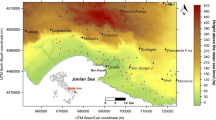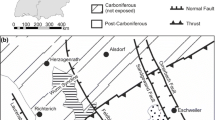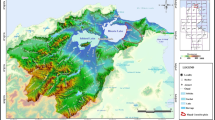Abstract
The coastal alluvial plain of Sarno River (Campania Region, southern Italy) is a very rich environment that has experienced a long history of changes due to both natural phenomena such as eustatic sea-level variations and deposition of volcanoclastic sediments, and human civilizations who populated this area since historical times. As a result, it is characterized by complex stratigraphic sequences and groundwater flow systems. The architecture of the multi-layered aquifer system in a sample area, located in a densely urbanized sector at the mouth of Sarno River, was reconstructed. Starting from the analysis of stratigraphic log data and laboratory geotechnical measurements, the lithostratigraphical-unit sequence was retrieved and a realistic three-dimensional (3D) model of the hydrogeological heterogeneity was obtained. The results of a detailed 2D electrical resistivity tomography survey were used to support the analysis of the spatial heterogeneity of the aquifer system in a sector characterized by lack of log data. The integration of hydrogeological and geophysical data allowed for the reconstruction of a 3D hydrogeophysical model of the multi-layered system, which electrically characterizes and geometrically identifies two aquifers. Finally, piezometric-level measurements validated the hydrogeological–geophysical model and showed the effectiveness of the methodology.
Résumé
La plaine alluviale côtière de la Rivière Sarno (Campanie, Sud de l’Italie) est un milieu très riche qui a une longue histoire de transformations dues à la fois à des phénomènes naturels, tels les variations eustatiques et le dépôt de sédiments pyroclastiques et aux civilisations qui ont occupé cette zone depuis des temps historiques. Il en résulte des séquences stratigraphiques et des systèmes d’écoulement souterrain complexes. L’architecture du système aquifère multicouche a été reconstituée dans une zone test, localisée dans un secteur densément urbanisé à l’embouchure de la Rivière Samo. Partant de l’analyse de données de logs stratigraphiques et de mesures géotechniques en laboratoire, on a reconstitué la séquence lithostratigraphique unité et abouti à un modèle 3D réaliste des hétérogénéités hydrogéologiques. Les résultats d’une campagne de tomographie détaillée de la résistivité électrique 2D ont été utilisés pour conforter l’analyse de l’hétérogénéité spatiale du système aquifère dans un secteur caractérisé par un manque de données stratigraphiques. L’intégration des données hydrogéologiques et géophysiques a permis la restitution d’un modèle 3D du système multicouche, qui caractérise électriquement et identifie géométriquement deux aquifères. Finalement, des mesures de niveaux piézométriques ont validé le modèle hydrogéologique et géophysique et montré l’adéquation de la méthodologie.
Resumen
La planicie costera aluvial del Río Sarno (Región de Campania, sur de Italia) es un ambiente muy rico que ha experimentado una larga historia de cambios debido tanto a fenómenos naturales, tales como variaciones eustáticos del nivel del mar y depositación de sedimentos volcánicos, como a las civilizaciones humanas que poblaron esta área desde tiempos históricos. Como resultado, se caracteriza por secuencias estratigráficas y sistemas de flujo de aguas subterráneas complejos. Se reconstruyó la arquitectura del sistema acuífero multicapa en un área de muestreo, localizada en un sector densamente urbanizado en la boca del Río Sarno. Comenzando por el análisis de datos de registros estratigráficos y medidas geotécnicas de laboratorio, se recuperó la secuencia de unidades litoestratigráficas y se obtuvo un modelo realístico tridimensional de la heterogeneidad hidrogeológica. Los resultados de un relevamiento tomográfico de resistividad eléctrica 2 D fueron usados para apoyar el análisis de la heterogeneidad espacial del sistema acuífero en un sector caracterizado por la carencia de datos de registros. La integración de datos geofísicos e hidrogeológicos permitió la reconstrucción de un modelo hidrogeológico 3D del sistema mulitcapa, el que caracteriza eléctricamente y identifica geométricamente dos acuíferos. Finalmente, medidas de niveles piezométricos validaron el modelo hidrogeológico–geofísico y mostraron la efectividad de la metodología.
摘要
(意大利南部Campania地区)Sarno河沿海冲积平原是一个非常富有的地区,由于海面升降变化和火山碎屑沉积物沉积及人类从很早以来就居住在此地,本地区经历过长期的变化。因此,地层序列和地下水系统非常复杂。重建了位于Sarno河口密集城市化地区样区中多层含水层系统的构造。从分析地层记录数据和实验室岩土测量数据入手,获取了岩性地层单元序列,得出了逼真的水文地质不均匀性三维模型。详细的二维电阻率断层摄影调查结果用来支持缺乏录井数据地区含水层系统的空间不均匀性分析。水文地质和地球物理数据的整合可以重建多层含水层的三维水文地质模型,这个模型电学上可以描述两个含水层,几何学上可以确定两个含水层。最后,测压水位测量结果验证了水文地质-地球物理模型,显示了方法的有效性。
Resumo
A planície costeira aluvial do rio Sarno (Campânia, sul de Itália) é um ambiente muito rico que foi alvo de uma longa história de alterações devidas a fenómenos naturais, tais como variações eustáticas do nível do mar e a deposição de sedimentos vulcaniclásticos, e civilizações humanas que povoaram esta área desde tempos históricos. Em resultado disso, caracteriza-se por sequências estratigráficas e por sistemas de escoamento de águas subterrânea complexos. Foi reconstruída a arquitetura do sistema aquífero multicamada numa área-amostra localizada numa zona densamente urbanizada na foz do rio Sarno. Partindo da análise de dados de diagrafias estratigráficas e de resultados geotécnicos laboratoriais foi concebida a sequência de unidades litoestratigráficas e foi obtido um modelo realístico tridimensional (3D) da heterogeneidade hidrogeológica. Foram usados os resultados de um levantamento tomográfico detalhado 2D de resistividade elétrica para apoiar a análise da heterogeneidade especial do sistema aquífero num sector caracterizado pela ausência de dados de diagrafias. A integração de dados hidrogeológicos e geofísicos permitiu a reconstrução de um modelo hidro-geofísico 3D do sistema multicamada, o qual caracteriza elétrica e geometricamente dois aquíferos. Finalmente, as medições de nível piezométrico validaram o modelo hidrogeológico–geofísico e mostraram a eficácia da metodologia.











Similar content being viewed by others
References
Ahmed S, Marsily G, Talbot A (1988) Combined use of hydraulic and electrical properties of an aquifer in a geostatistical estimation of transmissivity. Groundwater 26:78–86
Aprile F, Toccaceli R, Sbrana A (2004) Il ruolo dei depositi piroclastici nell’analisi cronostratigrafica dei terreni quaternari del sottosuolo della Piana Campana [The role of pyroclastic deposits in the chronostratigraphic analysis of Quaternary terrains in the Campania Plain subsoil]. Il Quaternario 17:547–554
Archie GE (1942) The electrical resistivity log as an aid in determining some reservoir characteristics. Trans AIME 146:54–62
Balducci S, Vaselli M, Verdini G (1983) Exploration well in the Ottaviano permit, Italy, Trecase 1. Eur. Geot. Update, 3rd Int. Sem., Munich, 29 November–1 December 1983, pp 407 – 418
Barberi F, Innocenti F, Lirer L, Munno R, Pescatore T, Santacroce R (1978) The Campanian Ignimbrite: a major prehistoric eruption in the Neapolitan area (Italy). Bull Volcanol 41:1–22
Barberi F, Cioppi D, Ghelardoni R, Nannini R, Sommaruga C, Verdiani G (1980) Integrated geothermal reconaissance of the Somma-Vesuvius system. 2nd Int. Sem. Results E.C. Geothermal Energy Res., Strasbourg, March 1980, pp 141–153
Barra D, Romano P, Santo A, Campaiola L, Roca V, Tuniz C (1996) The Versilian transgression in the Volturno river plain (Campania, southern Italy): paleoenvironmental history and chronological data. Il Quaternario 9:445–458
Beven K (2007) Towards integrated environmental models of everywhere: uncertainty, data and modeling as a learning process. Hydrol Earth Syst Sci 11:460–467
Brancaccio L, Cinque A, Romano P, Rosskopf C, Russo F, Santangelo N, Santo A (1991) Geomorphology and neotectonic evolution of a sector of the Tyrrhenian flank of the southern Apennines (region of Naples, Italy). Zeitschrift Geomorphol Suppl 82:47–58
Brocchini D, Principe C, Castratori D, Laurenzi MA, Gorla L (2001) Quaternary evolution of the southern sector of the Campania Plain and early Somma-Vesuvius activity: insights from the Trecase 1 well. Mineral Petrol 73:67–91
Cassiani G, Binley AM (2005) Modeling unsaturated flow in a layered formation under quasi-steady state conditions using geophysical data constraints. Adv Water Resour 28:467–477
Cassiani G, Böhm G, Vesnaver A, Nicolich R (1998) A geostatistical framework for incorporating seismic tomography auxiliary data into hydraulic conductivity estimation. J Hydrol 206:58–74
Catuneanu O (2006) Principles of sequence stratigraphy. Elsevier, Amsterdam
Celico F, Piscopo V (1995) Idrodinamica sotterranea e vulnerabilità all’inquinamento delle piane del Sarno e della Solofrana (Campania) [Groundwater flow and pollution vulnerability of the Sarno and Solofrana River plains (Campania Region)]. Quad Geol Appl 2:407–414
Chandra S, Ahmed S, Ram A, Dewandel B (2008) Estimation of hard rock aquifers hydraulic conductivity from geoelectrical measurements: a theoretical development with field application. J Hydrol 357:218–227
Chen J, Hubbard S, Peterson J, Williams K, Fienen M, Jardine P, Watson D (2006) Development of a joint hydrogeophysical inversion approach and application to a contaminated fractured aquifer. Water Resour Res 42, W06425
Cinque A, Patacca E, Scandone P, Tozzi M (1993) Quaternary kinematic evolution of the Southern Apennines: relationships between surface geological features and deep lithospheric structures. Annal Geofis 36:249–259
Daily WA, Ramirez A, Labrecque D, Nitao J (1992) Electrical resistivity tomography of vadose water movement. Water Resouces Res 28:1429–1442
De Marsily G, Delay F, Goncalvès J, Renard P, Teles V, Violette S (2005) Dealing with spatial heterogeneity. Hydrogeol J 13:161–183
De Vivo B, Rolandi G, Gans PB, Calvert A, Bohrson WA, Spera FJ, Belkin HE (2001) New constraints on the pyroclastic eruptive history of Campanian volcanic plain (Italy). Miner Petrol 73:47–65
Di Maio R, Piegari E (2011) Water storage mapping of pyroclastic covers through resistivity measurements. J Appl Geophys 75:196–202
Di Maio R, Mauriello P, Patella D, Petrillo Z, Piscitelli S, Siniscalchi A (1998) Electric and electromagnetic outline of the Mount Somma-Vesuvius structural setting. J Volcanol Geotherm Res 82:219–238
Drahor MG, Berge MA, Göktürkler G, Kurtulmuş TO (2011) Mapping aquifer geometry using electrical resistivity tomography: a case study from Şanlıurfa, south-eastern Turkey. Near Surf Geophys 9:55–66
Fabbrocino S, Lanari R, Celico P, Termolini G, Zeni G (2007) Groundwater pumping and land subsidence in the Sarno River plain. Mem Descr Carta Geol Ital 76:163–174
Felletti F, Bersezio R, Giudici M (2006) Geostatistical simulation and numerical upscaling to model groundwater flow in a sandy-gravel, braided river, aquifer analogue. J Sedimen Res 76:1215–1229
Ferré T, Bentley L, Binley A, Linde N, Kemna A, Singha K, Holliger K, Huisman JA, Minsley B (2009) Critical steps for the continuing advancement of hydrogeophysics. EOS Trans AGU 90:200. doi:10.1029/2009EO230004
Galloway DL (2010) The complex future of hydrogeology. Hydrogeol J 18:807–810
Gasparini P (1998) Looking inside Mt Vesuvius. EOS Trans AGU 79:229–232
Hinnel AC, Ferrè TPA, Vrugt JA, Huisman JA, Moysey S, Rings J, Kowalsky MB (2010) Improved extraction of hydrological information from geophysical data through coupled hydrogeophysical inversion. Water Resour Res. doi:10.1029/2008WR007060
Hsien-Tsung L, Yih-Chi T, Chu-Hui C, Hwa-Lung Y, Shih-Ching W, Kai-Yuan K (2010) Estimation of effective hydrogeological parameters in heterogeneous and anisotropic aquifers. J Hydrol 389:57–68
Hubbard S, Rubin Y (2002) Hydrogeophysics: state-of-the-discipline. EOS Trans AGU 83:602–606
Hubbard S, Rubin Y, Majer E (1999) Spatial correlation structure estimation using geophysical and hydrogeological data. Water Resour Res. doi:10.1029/1999WR900040
Huntley D (1986) Relations between permeability and electrical resistivity in granular aquifers. Groundwater 24:466–474
Hyndman DW, Harris JM, Gorelick SM (1994) Coupled seismic and tracer test inversion for aquifer property characterization. Water Resour Res 30:1965–1977
Kelly WE, Frohlich KR (1985) Relation between aquifer electrical and hydraulic properties. Groundwater 23:182–189
Koch K, Wenninger J, Uhlenbrook S, Bonnell M (2009) Joint interpretation of hydrologic and geophysical data: electrical resistivity tomography results from a process hydrological research site in the Black Forest Mountains Germany. Hydrol Process 23:1501–1513
Kowalsky MB, Finsterle S, Peterson J, Hubbard S, Rubin Y, Majer E, Ward A, Gee G (2005) Estimation of field‐scale soil hydraulic and dielectric parameters through joint inversion of GPR and hydrological data. Water Resour Res. doi:10.1029/2005WR004237
Laney RL, Davidson CB (1986) Aquifer nomenclature guidelines. US Geol Surv Open-File Rep 86-594
La Torre P, Nannini R, Sbrana A (1983) Geothermal exploration in southern Italy: geophysical interpretation of Vesuvian area. Boll Geofis Teor Appl 26:197–208
Lemon AM, Jones NL (2003) Building solid models from boreholes and user defined cross sections. Comput Geosci 29:547–555
Linde N, Binley A, Tryggvason A, Pedersen LB, Revil A (2006) Improved hydrogeophysical characterization using joint inversion of crosshole electrical resistance and ground penetrating radar traveltime data. Water Resour Res. doi:10.1029/2006WR005131
Loke M H (2004) Tutorial: 2-D and 3-D electrical imaging surveys. http://www.cas.umt.edu/geosciences//faculty/sheriff/495-subsurface imaging in archaeology/Sources/Loke_elect_tutorial.pdf. Accessed 25 September 2013
Loke MH, Barker RD (1996) Rapid least-squares inversion of apparent resistivity pseudosections using a quasi-Newton method. Geophys Prospect 44:131–152
Loke MH, Dahlin T (2002) A comparison of the Gauss-Newton and the quasi-Newton methods in resistivity imaging inversion. J Appl Geophys 49:149–162
Luongo G, Perrotta A, Scarpati C (2003) Impact of AD 79 explosive eruption on Pompeii. I. Relationship among depositional mechanisms of the pyroclastic products, the framework of the buildings and the associated destructive events. J Volcanol Geoth Res 126:201–223
Marturano A, Aiello G, Barra D (2011) Evidence for late Pleistocene uplift at the Somma-Vesuvius apron near Pompeii. J Volcanol Geoth Res 202:211–227
Mele M, Bersezio R, Giudici M (2012) Hydrogeophysical imaging of alluvial aquifers: electrostratigraphic units in the quaternary Po alluvial plain (Italy). Int J Earth Sci 101:2005–2025
Ogilvy RD, Kuras O, Meldrum PI, Wilkinson PB, Chambers JE, Sen M, Ginsbert J, Jorreto S, Frances I, Pulido-Bosh A, Tsourlos P (2009) Automated time-lapse electrical resistivity tomography (ALERT) for monitoring coastal aquifers. Near Surf Geophys 7:367–375
Ortolani F, Aprile F (1985) Principali caratteristiche stratigrafiche e strutturali dei depositi superficiali della Piana Campana [Main stratigraphic and structural features of shallow deposits of the Campania Plain]. Boll Soc Geol Ital 104:195–206
Ouellon T, Lefebvre R, Marcotte D, Boutin A, Blais V, Parent M (2008) Hydraulic conductivity heterogeneity of a local deltaic aquifer system from the kriged 3D distribution of hydrofacies from borehole logs, Valcartier, Canada. J Hydrol 351:71–86
Patacca E, Sartori R, Scandone P (1990) Tyrrenian basin and apenninic arcs: kinematic relations since late Tortonian times. Mem Soc Geol Ital 45:425–451
Pescatore T, Senatore MR, Capretto G, Lerro G (2001) Holocene costal environments near Pompeii before A.D. 79 eruption of mount Vesuvius (Italy). Quat Res 55:77–85
Poland JF, Lofgren EE, Riley FS (1972) Glossry of selected terms useful in studies of the mechanics of aquifer systems and land subsidence due to fluid withdrawal. US Geol Surv Water Suppl Pap 2025, 9 pp
Robins NS, Rutter HK, Dumpleton S, Peach DW (2005) The role of 3D visualization as an analytical tool preparatory to numerical modeling. J Hydrol 301:287–295
Rolandi G, Bellucci F, Heizler MT, Belkin HE, De Vivo B (2003) Tectonic controls on the genesis of ignimbrites from the Campanian Volcanic Zone, southern Italy. Miner Petrol 79:3–31
Romano P, Santo A, Voltaggio M (1994) L’evoluzione geomorfologica della pianura del F. Volturno (Campania) durante il tardo Quaternario (Pleistocene medio-superiore Olocene) [Geomorphological evolution of the Volturno River plain (Campania) in the late Quaternary (mid-late Pleistocene Holocene)]. Il Quaternario 7:41–56
Rubin Y, Hubbard S (2005) Inverse and forward modeling using multiple data sets: the hydrogeophysical challenge. In: Rubin Y, Hubbard S (eds) Hydrogeophysics. Springer, Dordrecht, The Netherlands
Sandberg SK, Slater LD, Versteeg R (2002) An integrated geophysical investigation of the hydrogeology of an anisotropic unconfined aquifer. J Hydrol 267:227–243
Santacroce R, Cioni R, Marianelli P, Sbrana A, Sulpizio R, Zanchetta G, Donahue DJ, Joron JL (2008) Age and whole rock-glass compositions of proximal pyroclastics from the major explosive eruptions of Somma-Vesuvius: a review as a tool for distal tephrostratigraphy. J Volcanol Geoth Res 177:1–18
Sinha R, Israil M, Singhal DC (2009) A hydrogeophysical model of the relationship between geoelectric and hydraulic parameters of anisotropic aquifers. Hydrogeol J 17:495–503
Slater L (2007) Near surface electrical characterization of hydraulic conductivity: from petrophysical properties to aquifer geometries—a review. Surv Geophys 28:169–197
Tronicke J, Holliger K (2005) Quantitative integration of hydrogeophysical data: conditional geostatistical simulation for characterizing heterogeneous alluvial aquifers. Geophysics 70:H1–H10
Vanderborght J, Kemna A, Hardelauf H, Vereecken H (2005) Potential of electrical resistivity tomography to infer aquifer transport characteristics from tracer studies: a synthetic case study. Water Res Resour. doi:10.1029/2004WR003774
Vereecken H, Binley A, Cassiani G, Revil A, Titov K (2006) Applied hydrogeophysics. Springer, Dordrecht, The Netherlands. doi:10.1007/978-1-4020-4912-5_1
Vienken T, Dietrich P (2011) Field evaluation of methods for determining hydraulic conductivity from grain size data. J Hydrol 400:58–71
Zollo A, D’Auria L, De Matteis R, Herrero A, Virieux J, Gasparini P (2001) Bayesian estimation of 2-D P-velocity models from active seismic arrival time-data: imaging of the shallow structure of Mt. Vesuvius (southern Italy). Geophys J Int 151:506–582
Zollo A, Gasparini P, Virieux J, Le Meur H, De Natale G, Biella G, Boschi E, Capuano P, De Franco R, Dell’Aversana P, De Matteis R, Guerra I, Iannaccone G, Mirabile L, Vilardo G (1996) Seismic evidence for a low-velocity zone in the upper crust beneath Mount Vesuvius. Science 274:592–594
Acknowledgements
Authors are grateful to Pasquale Paduano for his very friendly collaboration. Authors wish to thank Roberto Balia and an anonymous reviewer for their useful suggestions and comments, which helped improve the manuscript.
Author information
Authors and Affiliations
Corresponding author
Rights and permissions
About this article
Cite this article
Di Maio, R., Fabbrocino, S., Forte, G. et al. A three-dimensional hydrogeological–geophysical model of a multi-layered aquifer in the coastal alluvial plain of Sarno River (southern Italy). Hydrogeol J 22, 691–703 (2014). https://doi.org/10.1007/s10040-013-1087-8
Received:
Accepted:
Published:
Issue Date:
DOI: https://doi.org/10.1007/s10040-013-1087-8




